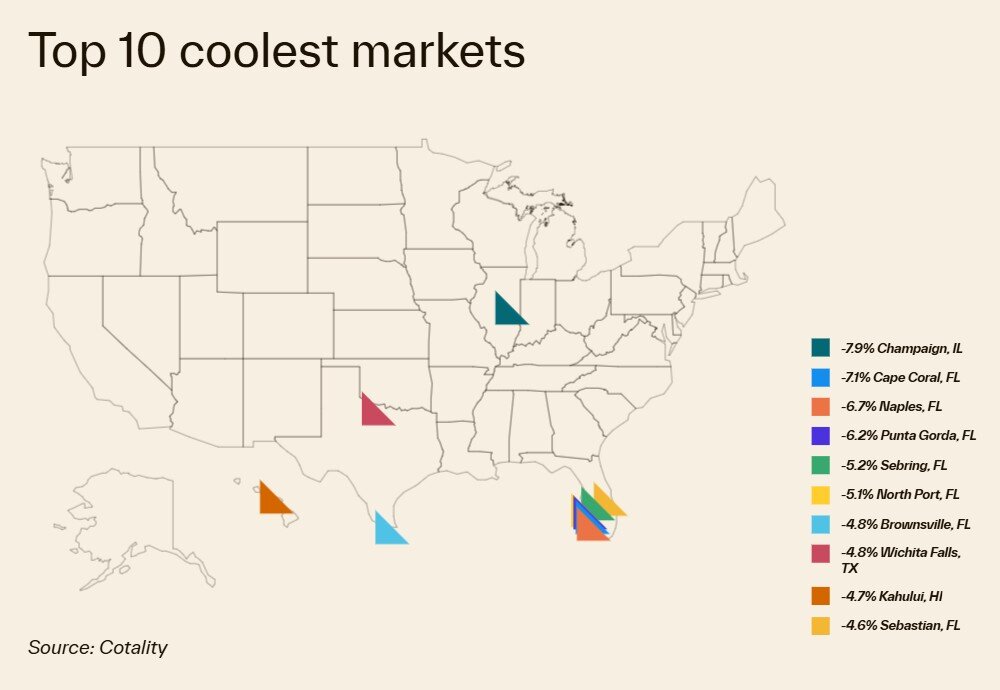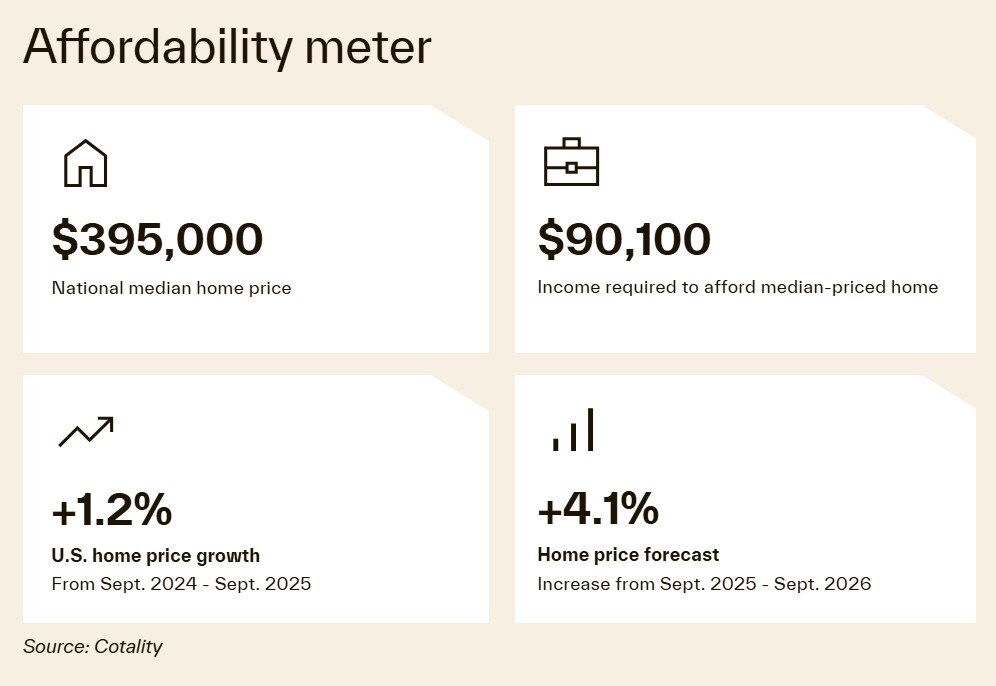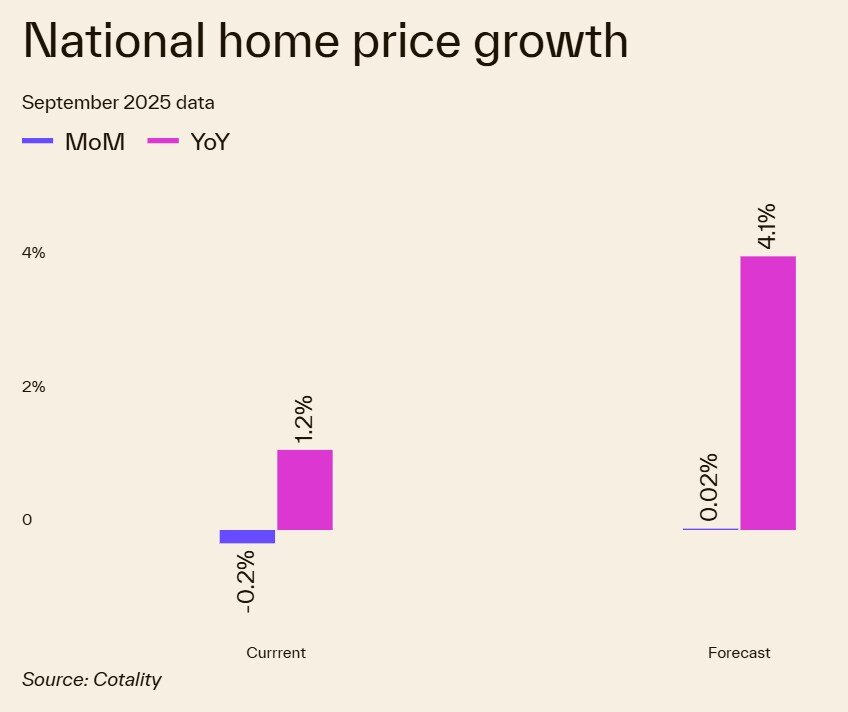Residential Real Estate News

U.S. Home Prices Go Flat in September as Inventory Climbs to Six-Year High
Residential News » Irvine Edition | By Michael Gerrity | November 6, 2025 7:52 AM ET
According to the latest Cotality Home Price Index, U.S. home price growth slowed to its weakest pace in nearly two years in September 2025, as rising housing inventory and cooling demand weighed on values across much of the country.
The index showed national prices up 1.2% from a year earlier, underscoring a market that is gradually losing steam. Total housing inventory reached its highest level since 2019, giving buyers more choices but also contributing to a moderation in price gains.
While the Northeast continues to defy the slowdown, with home values climbing at a high single-digit rate, other regions are seeing uneven performance. Alaska and Wyoming, which had lagged for much of the past two years, posted a surprise rebound with price gains above 5% year-over-year.
At the metro level, signs of weakness are spreading. About 20% of the 411 metropolitan areas tracked by Cotality recorded annual price declines in September -- the largest share since June 2023, when surging mortgage rates last cooled the market.
"Much like the K-shaped trend in consumer spending -- where higher-income households continue to spend while lower-income groups pull back -- today's housing market reflects widening affordability gaps," said Dr. Selma Hepp, Cotality's chief economist. "Weaker job growth, sluggish wages, and deteriorating household finances are dampening demand among lower-income buyers, putting downward pressure on prices."
Though mortgage rates have eased in recent weeks and home prices have softened in some markets, affordability remains a major hurdle. Cotality's analysis found that three-quarters of the top 100 housing markets remain overvalued, and real mortgage payments -- excluding taxes and insurance -- are up 72% from pre-pandemic levels.
Still, strength in the Northeast is propping up national averages. "Major metros such as Boston, New York, and Philadelphia remain resilient thanks to strong finance, biotech, healthcare, and education sectors," Hepp said. "These industries provide income stability and attract high-earning professionals who can sustain elevated home prices. Nearby mid-sized metros offering better value are also benefiting as hybrid workers look beyond city centers."
Analysts say that while the recent dip in borrowing costs could spark a modest pickup in demand heading into 2026, a broader recovery will likely depend on a steadier labor market and stronger consumer confidence.
Sign Up Free | The WPJ Weekly Newsletter
Relevant real estate news.
Actionable market intelligence.
Right to your inbox every week.
Real Estate Listings Showcase
Related News Stories
Residential Real Estate Headlines
- Pending Home Sales in U.S. Remain Flat in September
- Greater Palm Beach Area Residential Sales Posts Strong Gains in September
- U.S. Home Sales Uptick in September as Mortgage Rates Fall
- U.S. Single-Family Rent Growth Hits 15-Year Low
- U.S. Home Buyers Hold the Cards in Late 2025
- U.S. Renters Get First Price Break in Four Years this Fall
- Orlando Housing Market Gives Mixed Signals in September
- U.S. Foreclosure Filings Jump 17 Percent Annually in Q3 Signaling Borrower Strain
- Greater Las Vegas Housing Market Sees Price Cooling in September as Inventory Climbs
- Global Super-Prime Home Sales Surge in Mid-2025
- Greater Fort Lauderdale Area Residential Sales Drop 12 Percent in August
- UBS Flags Miami, Tokyo, Zurich as World's Top Housing Bubble Risk Markets in 2025
- Government Shutdown Threatens to Snarl the U.S. Housing Market, Cloud Fed Policy
- Home Price Growth Stalls as U.S. Housing Market Shows First Signs of Cooling in 2025
- Pending Home Sales Rise in August as Lower Rates Spur U.S. Buyers
- U.S. Homebuyer Affordability Improves for Fourth Straight Month
- U.S. New-Home Sales Surge in August as Mortgage Rates Ease
- Despite Increased Foreign Buyer Activity, Miami Residential Sales Dip 11 Percent in August
- California Home Sales Enjoy Modest Uptick as Mortgage Rates Ease
- U.S. Home-Flipping Profits Sink to Lowest Level Since 2008 Financial Crisis as Costs Climb
- Why the World's Rich Are Flocking to Europe in 2025
- Federal Reserve Delivers First Rate Cut of 2025 as Mortgage Relief Proves Limited
- Homebuilder Sentiment Holds Steady in U.S. as Rate-Cut Bets Lift Outlook
- U.S. Mortgage Rates Experience Sharpest Weekly Drop in Over a Year
- U.S. Foreclosures Rise for Sixth Straight Month as Affordability Pressures Mount
- Black U.S. Homeownership Rate Falls to Two-Year Low as Job Losses Mount
- Las Vegas Home Prices Flatten as Listings Surge, Sales Slow
- Cooling Miami Housing Market Sees 16 Percent Annual Sales Drop in July
- U.S. Mortgage Delinquencies Uptick in June Amid Regional Pressures
- California, Florida Top U.S. Housing Markets Most at Risk of Downturn
- 30-Year Mortgage Drops to 6.56 Percent in Late August, Lowest Since October 2024
- Investors Maintain Elevated Role in U.S. Housing Market Despite Slight Pullback
- Pending Home Sales Show Mixed Signals as U.S. Buyers Remain Cautious
- Canadian Home Sales Extend Recovery in July
- U.S. Home Sales Rise in July as Buyers Gain More Bargaining Power
- Zombie Foreclosures Edge Up Across U.S.
- 2.6 Million Homes at Wildfire Risk Across 14 Western States in 2025
- One in Five Americans Willing to Trade Personal Safety for Home Affordability
- U.S. Home Price Growth Slows as Affordability Pressures Mount in 2025
- U.S. Mortgage Rates Dip to Four Month Low in Early August











